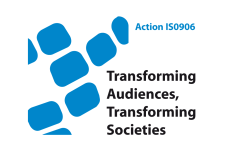- About the Action
- Events
- PhD workshop - Ljubljana 2014
- Action Open Conference - Ljubljana 2014
- New Media and Participation conference - Istanbul 2013
- Belgrade meeting 2013
- Media literacy research and policy - Brussels 2013
- ICA Pre-Conference 2013
- Tampere meeting 2013
- Budapest workshop 2012
- Milan meeting 2012
- Brussels PhD workshop 2012
- Brussels Action workshop 2012
- London meeting 2011
- Zagreb Conference 2011
- Lisbon meeting 2010
- Affiliated events
- WG 1
- WG 2
- WG 3
- WG 4
- Cross-WG
- Output
New WG2 special issue: Participatory Journalism: Possibilities and Constraints for Audience Participation
New special issue of the COST Action IS0906: ‘Transforming Audiences, Transforming Societies’: Working Group 2 ‘Audience Interactivity and Participation’
MEDIJSKA ISTRAŽIVANJA/MEDIA RESEARCH (2013, Vol. 19, No. 2):
Participatory Journalism: Possibilities and Constraints for Audience Participation
Editor-in-Chief: Nada Zgrabljic Rotar (University of Zadar, Croatia)
Guest Editor of the Special Issue: Igor Vobic (University of Ljubljana, Slovenia)
In late modern societies, communication is shaped by concepts such as heterogeneity, fragmentation and individualisation. Social networking sites, blogs, and micro-blogs have recently joined the billions of websites enabling different individual and collective actors that are scattered across the locales to participate in public communication in a variety of unprecedented ways. These online forms of communicative engagement have also facilitated the ideas of the collaborative and the collective in contemporary journalism of traditional media organisations. The “people formerly known as the audience”, as Jay Rosen acknowledged almost a decade ago, have actively started to contribute to the on-going processes of creating news websites in mainstream media and became variously engaged in participatory journalism.
Despite the fact that the idea of participatory journalism engages people both inside and outside the newsrooms to communicate, not only to, but also with each other, there have been indications of inclusivist, and also exclusivist principles and practices, of collective and collaborative news making. The different modes of audience participation in journalism have, in some cases, eliminated some of the traditional ideals in journalism, such as truthiness, the principle of objectivity, and a disinterest in the shaping of political life, and have replaced them with alternatives, such as deliberation, multiperspectivity, and participation in political life. In this sense, the ordinary people have with professional assistance captured and published through words, photographic, or video stories of worldwide significance, and have shared personal perspectives or particular views from their small communities on issues of a larger significance, thereby reshaping the dynamics between the global and the (micro-)local in public communication.
The authors of the articles that have been included in this special issue of Medijska istraživanja/Media Research consider the possibilities and constrains of participatory journalism to be the starting points of their explorations. The issue consists of five scholarly articles: one theoretical discussion on participatory journalism in the Internet age, and four case studies from the Netherlands, Slovenia, Serbia, and Belgium.
Contents:
Editorial
Igor Vobič
Reconsidering Participatory Journalism in the Internet Age
Igor Vobič, Peter Dahlgren
Available at: http://hrcak.srce.hr/index.php?show=clanak&id_clanak_jezik=165840
“It really is a Craft”: Repertoires in Journalistic Frontrunners’ Talk on Audience Participation
Merel Borger, Irene Costera Meijer, Anita van Hoof, Jose Sanders
Available at: http://hrcak.srce.hr/index.php?show=clanak&id_clanak_jezik=165842
Abuse of Online Participatory Journalism in Slovenia: Offensive Comments under News Items
Karmen Erjavec, Melita Poler-Kovačič
Available at: http://hrcak.srce.hr/index.php?show=clanak&id_clanak_jezik=165843
Co-construction and Deconstruction of Poverty on Serbian News Websites
Jelena Kleut, Smiljana Milinkov
Available at: http://hrcak.srce.hr/index.php?show=clanak&id_clanak_jezik=165844
Identity, Contingency and Rigidity: The (Counter-) hegemonic Constructions of the Identity of the Media Professional
Nico Carpentier
Only available in the printed edition.
MEDIJSKA ISTRAŽIVANJA/MEDIA RESEARCH
http://www.mediaresearch.cro.net/
See also:
Portal of scientific journals of Croatia
http://hrcak.srce.hr/?lang=en
http://hrcak.srce.hr/mediaresearch

